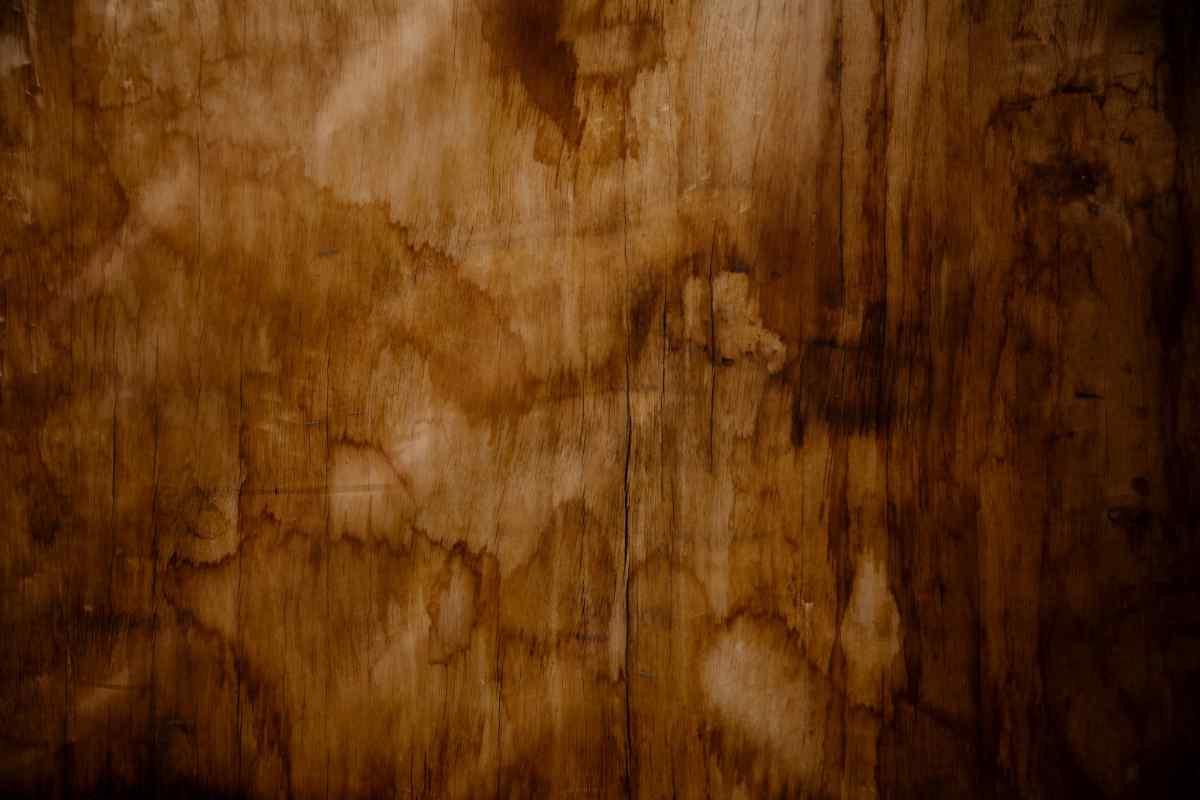You set down a sweaty glass, blink, and, ugh, there’s a ghostly ring on your table. The good news: most water marks aren’t permanent. With the right steps (and a little patience) you can clear the haze, even on older pieces. Let me walk you through what’s really going on, what to try first, and when to call in the heavy hitters.
First, what kind of “water stain” is it?
White or cloudy rings
- Look milky, gray, or hazy.
- Moisture is trapped in the finish (wax, shellac, lacquer, or polyurethane), not in the wood.
- Usually recent; usually fixable with low risk methods like gentle heat or oil-based “displacement.”
Dark or black patches
- Coffee-ring dark, even charcoal in spots.
- Moisture reacted with minerals/iron and tannins in the wood fibers (common on oak).
- Needs lightening (peroxide or oxalic acid) and often a refinish to blend the color.
Heat marks vs. water rings
- Both can look white. Low, controlled heat can re-open the finish so moisture can escape—so heat is a smart, gentle first step for fresh white marks.
Antiques & delicate finishes
- Shellac/French polish and wax are stain-prone and easier to mar. Favor mild, finish-friendly products (ring remover creams + beeswax) before trying home brews.
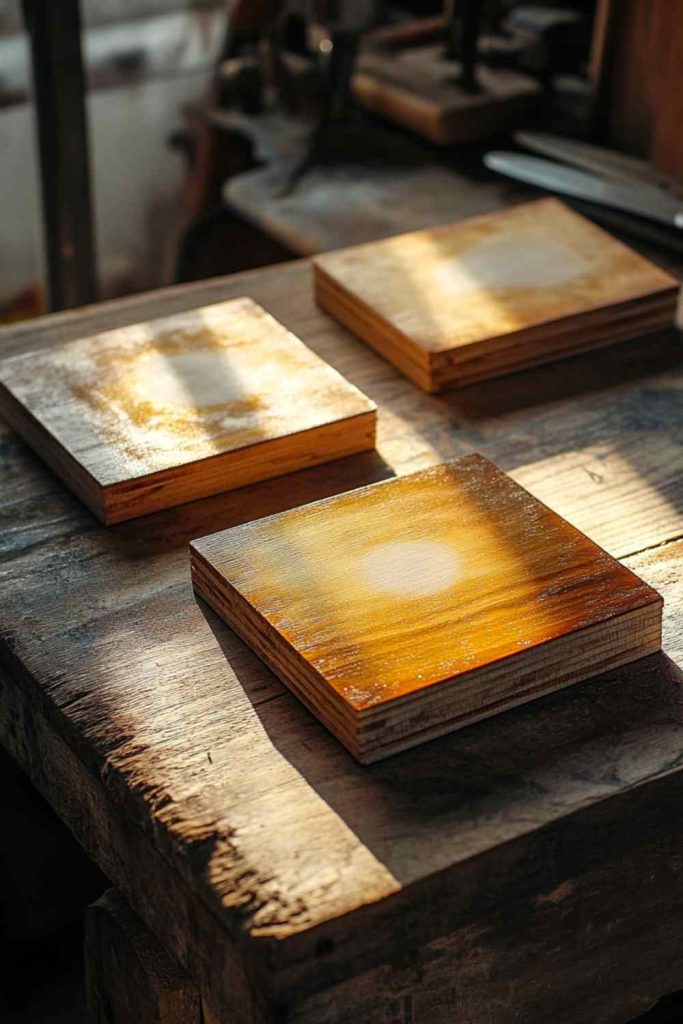
Safety, tools & test protocol (quick but important)
Always test first
- Pick an inconspicuous spot. If you know the finish, choose methods that match it. Realistically? Assume you don’t, so start mild and escalate.
Minimal starter kit
- Microfiber cloths; hair dryer; clothes iron.
- White non-gel toothpaste; baking soda; mineral/olive oil.
- White vinegar (for vinegar-oil polish mixes), mayonnaise or petroleum jelly.
- #0000 (super fine) steel wool + mineral oil (advanced).
- 3% hydrogen peroxide; household chlorine bleach (never mix with peroxide); oxalic acid crystals (for black/iron stains).
- Nitrile gloves; eye protection; ventilation.
General cautions
- Don’t mix chemicals (especially peroxide + chlorine bleach).
- Keep applications thin; avoid soaking veneer; protect surrounding finish.
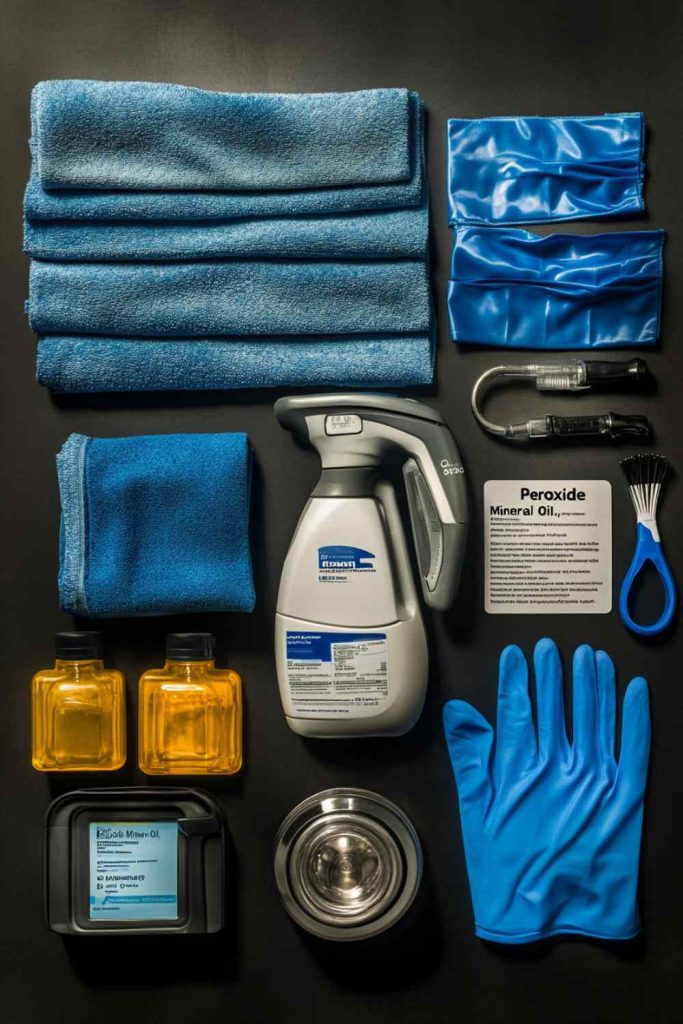
Fast decision guide: what to try first
Fresh, white ring (minutes to a few days old)
- Low heat (hair dryer on lowest setting) →
- Iron through a dry cotton cloth in short passes →
- Oil displacement (mayonnaise or petroleum jelly; or a vinegar–olive oil polish) →
- Toothpaste/baking soda (gentle rubs) →
- Commercial ring remover; finish with beeswax on antique/waxed pieces.
White blush on waxed/oiled pieces
- Try a quick wipe with mineral spirits, let it flash off, then re-wax. (Often the haze is in the wax, not the film.)
Dark/black stains (plant pot, pet bowl, metal tray)
- Start with hydrogen peroxide poultice cycles →
- If it’s an iron/tannin black mark (very likely on oak), use oxalic acid solution, rinse well (many pros follow with a mild baking-soda rinse), dry, lightly sand, then refinish →
- For severe overall discoloration, consider two-part wood bleach (last resort) →
- If none of that works or the surface looks uneven, strip/sand and refinish the whole top for uniform color and sheen.
How to clear white/cloudy rings (surface moisture)
1) Low heat + airflow (hair dryer)
- Set to lowest heat; hold a few inches away; keep it moving side to side for 1–2 minutes.
- Pause, assess; repeat short cycles until the haze fades; buff dry.
- Least risky first try for fresh rings.
2) Warm iron through a cloth
- Put a dry cotton cloth over the mark.
- Low heat, no steam; 10-second passes, lift and check between passes.
- Stop if the finish softens.
3) Displace moisture with oil (mayonnaise / petroleum jelly / mineral or olive oil)
- Dab a very thin coat, let sit 1 hour; for stubborn haze, overnight is common; wipe clean; buff.
- Alternative polish: equal parts vinegar + olive oil; rub with the grain; wipe dry.
- Works well on many modern finishes. Skip on already raw/unfinished areas (can darken).
4) Toothpaste (white, non-gel) + baking soda
- Mix 1:1 to a small paste; pea-size amount on a microfiber cloth; rub gently 10–30 seconds; wipe and check; repeat if needed; finish with a light polish.
- It’s mildly abrasive, go easy to avoid sheen changes.
5) Waxed finishes: quick “de-blush” with mineral spirits
- Lightly dampen a cloth with mineral spirits; quick rub on the ring; let flash off; re-wax and buff.
- Handy when the stain sits in the wax layer.
6) Commercial ring remover + beeswax (especially on antiques)
- Follow label on a ring remover like Liberon Ring Remover; if haze creeps back, repeat after 24 hours.
- Top with a beeswax (Briwax/Liberon) and buff for glow and protection.
- Gentler approach on French-polished/waxed antiques.
7) Lacquer finishes only: re-flow the film (advanced)
- Spritz lacquer thinner or add a fresh lacquer coat to re-activate the film; trapped moisture vents as it re-hardens.
- Mask off, light touch; avoid on non-lacquer finishes.
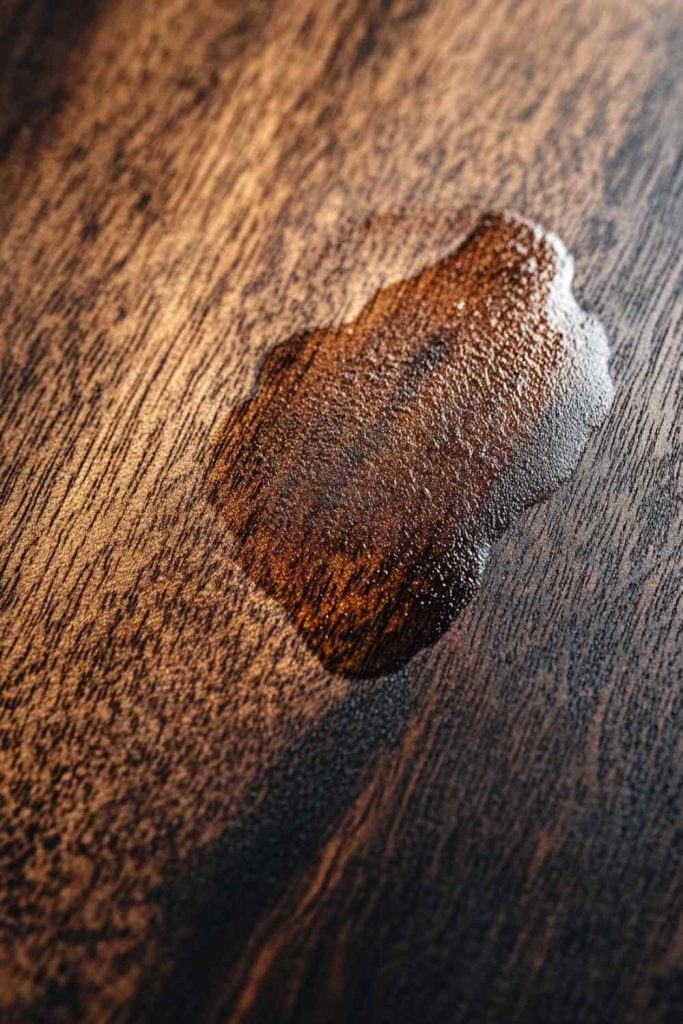
How to lighten dark/black water stains (into the wood)
Hydrogen peroxide (first line)
- Mix 1:1 water : 3% hydrogen peroxide, soak a white cloth, wring, and lay it on the stain ~10 minutes; remove; let dry completely; repeat as needed.
- Do not mix with chlorine bleach. Let the wood fully dry before any top coat.
Oxalic acid (for iron/tannin black marks—classic on oak)
- Dissolve crystals in hot water (e.g., roughly 3 oz per 32 oz hot water) until clear.
- Brush onto the stain; allow to dry; repeat once if needed.
- Rinse thoroughly with clean water; many pros follow with a mild baking-soda rinse to neutralize; dry overnight.
- Lightly sand raised grain; refinish to match.
- Oxalic targets iron/tannin black stains and is gentler to natural wood color than two-part bleach.
Two-part wood bleach (sodium hydroxide + peroxide) — last resort
- Use when you must remove overall wood color to even out severe discoloration; follow the kit sequence exactly.
- Expect to refinish the entire panel to blend.
When removal fails → refinish
- Feather-sanding just the spot can leave a “dish” or halo. Stripping and refinishing the whole top gives even sheen/color.
- For better moisture resistance next time, choose a quality polyurethane or compatible hardwax-oil schedule.
Special surfaces & easy-to-miss pitfalls
Antiques / shellac / French polish
- More sensitive to heat, abrasives, and harsh solvents; safer route is ring-remover → beeswax; get pro help if unsure.
Veneer
- Keep liquids/heat brief and thin; watch for glue-line failure or bubbles. If you see lifting, stop and reassess.
What not to do
- Skip aggressive scouring pads and Magic Erasers (they’re abrasive and can dull finishes).
- Don’t use undiluted vinegar or glass cleaners directly on finished wood (they can haze or damage the finish).
- WD-40? It’s commonly suggested, but tests/reporting say it typically doesn’t remove water rings and may leave residue.
3 mini “playbooks” you can follow today
A) The 10-minute heat session (fresh white ring)
- Wipe dust.
- Hair dryer at lowest heat, a few inches away; sweep for 1–2 minutes.
- Pause; if the haze lightens, repeat 2–3 cycles.
- If needed, switch to iron-through-cloth in ~10-second passes, checking each time.
- Buff dry; call it done or finish with a drop of oil for luster.
B) Mayo / petroleum jelly overnight rescue (stubborn white ring)
- Spread a thin film of mayonnaise or petroleum jelly over the ring.
- Cover with a paper towel; wait 1 hour to overnight.
- Wipe clean; buff.
- If it’s still shy of perfect, reapply, or follow with a vinegar-olive oil wipe to de-grease and polish.
C) Oxalic acid on a black oak mark (plant-pot ring)
- Mix ~3 oz oxalic in 32 oz hot water; stir to dissolve.
- Brush on the black mark; let dry; repeat once if needed.
- Rinse thoroughly; optional mild baking-soda rinse; dry overnight.
- Light sand; refinish to blend.
Real-world snapshots (because it helps to see wins)
- “White ring from a sweating glass” — cleared with heat
Low-heat dryer sweeps + short iron passes through a cloth; light ring faded within minutes. Finish stayed intact. - “Mixed results…until mayo overnight”
Thin coat for ~1.5 hours helped, but the overnight dwell made a bigger difference; wiped clean, followed with a light vinegar wipe to remove oiliness. - “Black mark from a plant pot on oak”
Two rounds of oxalic acid, rinse + optional baking-soda pass; light sanding; refinish; color blended well. - “Waxed antique with white blush”
Fast wipe with mineral spirits lifted the wax-deep haze; beeswax and a buff restored sheen.
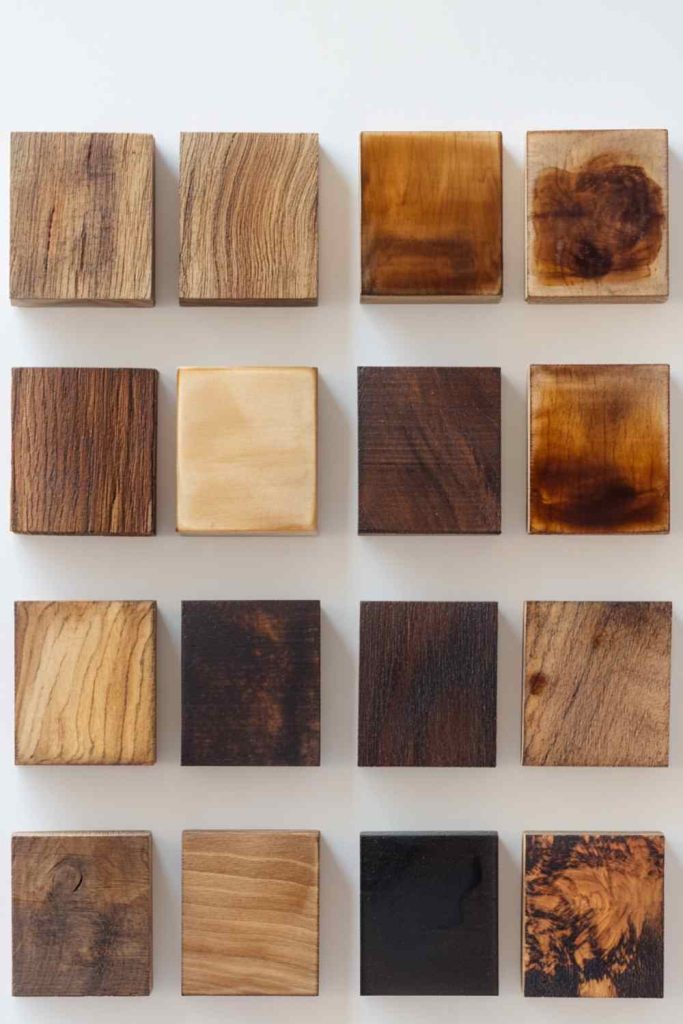
Why these fixes work (short nerdy detour)
- Heat softens and opens the finish so the trapped moisture can escape. That’s why dryers and low-heat irons are first line for white rings and heat marks.
- Oils (mayonnaise/petroleum jelly/mineral oil) can occupy the space that water took, evening out the refractive index so the haze disappears. (Plus they condition the top layer.)
- Peroxide (3%) is a gentle oxidizer, great for organic discoloration, and can lighten dark water marks without blasting the base color.
- Oxalic acid specifically targets iron/tannin complexes, the “black ring” chemistry, so it lightens without stripping out all the natural wood color the way two-part bleach can. Neutralize/rinse well.
- Lacquer re-flow works because lacquer is a “re-emulsifiable” film: thinner or a fresh coat re-dissolves the surface, letting moisture vent as it re-hardens.
Finish-matching tips (so the fix looks invisible)
- If you don’t know the finish, you can spot-test: dissolves with lacquer thinner = lacquer; denatured alcohol = shellac; neither = likely varnish/poly. (Test cautiously.)
- After any wet method, let the surface fully dry before top-coating.
- When in doubt, wax is a forgiving top-off on older, waxed or French-polished pieces—just keep it thin and buff well.
Prevention (so you don’t need this guide again)
- Coasters/trivets always, wipe spills right away, and don’t park hot-wet items directly on wood.
- Keep humidity moderate; polish/wax appropriate pieces on a schedule; avoid direct sun when possible.
FAQs
Why are some stains white and others black?
- White = moisture in the finish; black = moisture + iron/tannins in the wood. They’re treated differently.
How long should mayonnaise or petroleum jelly stay on?
- Try 1 hour first; stubborn rings often respond to overnight dwell. Wipe and buff after.
Can vinegar damage my finish?
- Dilution and context matter. Vinegar shows up in some polish mixes (often with oil), but using straight vinegar or glass cleaners on finished wood can haze/dull the finish. Test first.
Is toothpaste safe?
- Use white, non-gel toothpaste; rub gently and briefly, it’s mildly abrasive and over-rubbing can dull sheen.
Do I need to neutralize oxalic acid?
- Rinse thoroughly. Many pros optionally follow with a mild baking-soda rinse. Don’t “neutralize” an acid with vinegar, vinegar is also an acid.
What if the ring keeps coming back?
- Moisture may be deeper. Repeat the heat/oil method after a full dry, or step up to peroxide/oxalic protocols. Severe cases may need refinishing.
Are “ring remover” products worth it?
- On lacquer/shellac/wax finishes, especially antiques, dedicated ring removers plus a beeswax follow-up are effective and safer than DIY acids/solvents.
Can I use WD-40 or a Magic Eraser?
- WD-40 is typically ineffective on water rings and can leave residue; Magic Eraser is abrasive and can dull finishes.
Handy shopping list (brief)
- Hair dryer; cotton cloths; white toothpaste; baking soda.
- Mayonnaise/petroleum jelly; mineral oil/olive oil; white vinegar.
- #0000 steel wool + mineral oil (advanced users).
- 3% hydrogen peroxide; oxalic acid crystals; beeswax polish; Liberon Ring Remover (for antiques).
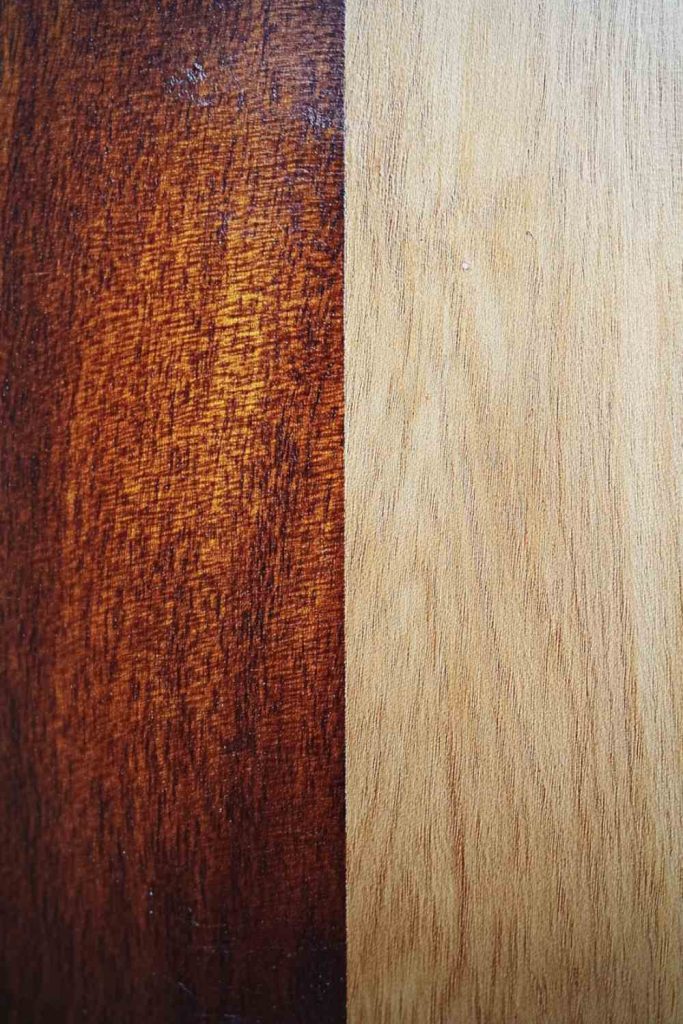
A final word
Honestly, you’ve got this. Start mild, move methodically, and don’t rush the drying steps. When you match the method to the stain, and respect the finish, those ghost rings usually vanish, and even the tough black marks can be tamed.

